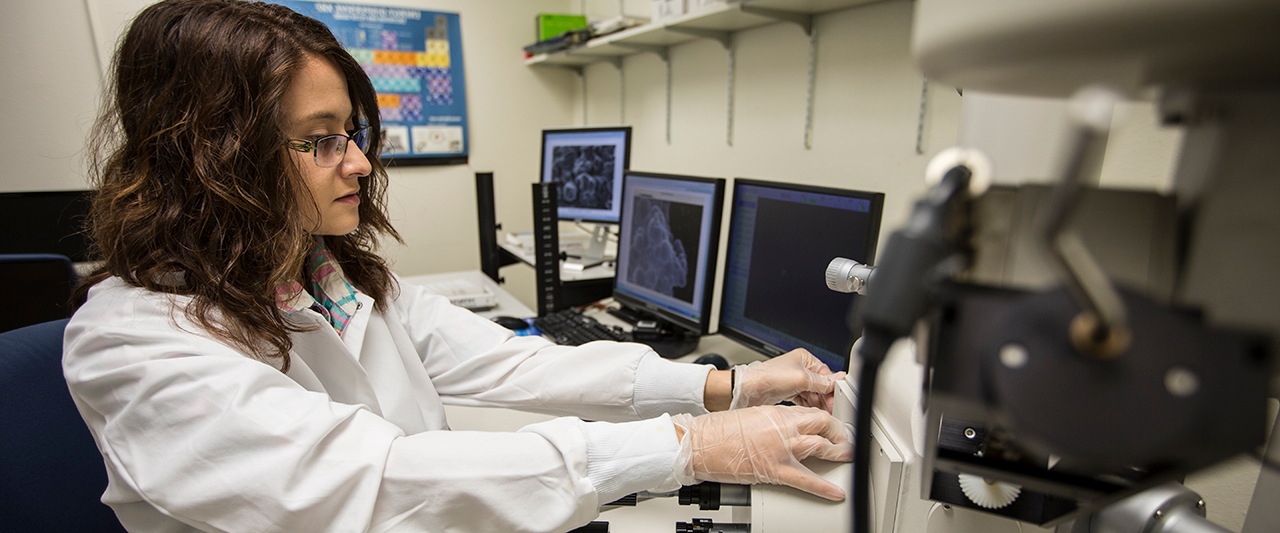
HAZMAT Safety Information
To report an incident or near miss in an NMT laboratory, please fill out an NMT Lab Incident/Near Miss Report.
If immediate medical attention is required, contact NMT Campus Police at 911 or 5555 from an on-campus phone, or 575-835-5555 from an off-campus phone.
If immediate hazard assessment is needed, please contact the Hazardous Materials and Laboratory Safety On-Call Phone (24 hrs a day) at 575-517-0646.
Mission
Our mission is to uphold university policy that states “New Mexico Tech is committed to providing a safe and healthy workplace for all its employees. The Institute complies with all applicable requirements issued by the state of New Mexico and the federal Occupational Health and Safety Administration (OSHA); and implements a site‐specific safety and health program for each of its facilities. Management and all employees share the responsibility for the success of the safety and health program. It is the policy of New Mexico Tech to exercise precautions necessary to protect employees from accidents.” (NMT Employee Handbook 2018, pg. 58)
For safety trainings and additional safety information go to Safety on Canvas. If you need access or assistance please contact Benjamin Thomas at hazmat@theabsolutelongestwebdomainnameinthewholegoddamnfuckinguniverse.com or 575-517-0646.
_____________________________________________________________________
Urgent 2024-2025 Hazmat Safety Information Update:
EPA Ruling on Dichloromethane
In 2024, The Environmental Protection Agency (EPA) finalized a rule under the Toxic Substances Control Act (TSCA) to mitigate the "unreasonable risk of injury to health" of methylene chloride (also known as methylene dichloride, methane dichloride, dichloromethane, and DCM; CAS # 75-09-2), a hazardous chemical known to cause several kinds of cancer as well as other health hazards.
The following form is required for any NMT researcher/ lab personnel or employee who has used DCM in the past two years in a NMT facility, is currently using DCM, or is planning on using DCM. It is imperative that any laboratory containing this chemical reports it to Research Compliance and Safety no later than December 20, 2024 using the form available here: Dichloromethane Usage Survey.
While this rule will not completely ban the use of methylene chloride in research settings, and labs will still be permitted to use methylene chloride, any lab on campus that will continue using this chemical will be required to have a Workplace Chemical Protection Program (WCPP) in place. Research Compliance and Safety will work with labs and/or facilities using DCM to develop a WCPP document in order to comply with the new EPA regulations. One important mandate of any WCPP is that it requires exposure threshold monitoring for any "potentially exposed persons". Research Compliance and Safety will guide NMT researchers to ensure that monitoring is performed as required by this rule.
In order to protect NMT students and employees, it is the official recommendation of NMT Research Compliance and Safety that NMT labs that currently utilize DCM in their labs plan on substituting other chemicals, wherever possible.
The following links provide information on methylene chloride and how research and academic laboratories will be affected by the new ruling. This information is also available in Appendix M of the most recent NMT Lab Safety Manual.
New Jersey Department of Health Right to Know Hazardous Substance Fact Sheet
How the EPA Ban of Methylene Chloride Will Impact Laboratories
What the Dichloromethane Ban Might Mean for University Labs in the US
Federal Register Methylene Chloride; Regulation Under the Toxic Substances Control Act (TSCA)
What Does the New EPA Methylene Chloride Rule Mean for Academic Labs?
Below is the current timeline for this new rule. I will provide further updates on timelines, monitoring, and other requirements as more information is available in this rapidly developing situation.
|
Required Actions |
EPA Deadline |
Target Dates for NMT Research Compliance |
|
Submit Dichloromethane Usage Survey |
N/A |
December 20, 2025 |
|
Initial Exposure Control Monitoring |
May 5th, 2025 |
January 2025 to April 1st, 2025 |
|
NMT Determines PPE and Provides Training |
August 1st, 2025 (or within 3 months of Initial Monitoring results) |
January 2025 to August 1st 2025 |
|
NMT Updates Chemical Hygiene Plan with WCPP inclusion |
October 30th, 2025 |
January 2025 to October 2025 |
New Mexico Tech Research Compliance and Safety needs your help to ensure compliance with this new ruling!
-
If your lab has DCM that is no longer in use, please submit a Chemical Hazardous Waste Pick Up Request form (below) to hazmat@theabsolutelongestwebdomainnameinthewholegoddamnfuckinguniverse.com at your earliest convenience. When the pick up is completed, please remove the DCM from your chemical inventory to reflect its disposal.
-
If your lab or facility has any paint removers, paint strippers, spray paints, automotive cleaners, adhesives, and varnish removers, you will need to check any of these items in their inventory list DCM is an ingredient, as DCM is commonly used in these types of products. Please submit a Chemical Hazardous Waste Pick Up Request form (below) to hazmat@theabsolutelongestwebdomainnameinthewholegoddamnfuckinguniverse.com for any of these products that contain DCM.
-
If your lab is currently using DCM for the following applications, you need to know that these applications are prohibited under the TSCA final ruling: paint, paint strippers in arts, coating removers, metal aerosols, and aerosol degreasing. Please note that the use of DCM in facilities for non-laboratory purposes is prohibited unless the use is specifically exempted by the EPA final rule.
Thank you for your cooperation and your attention to the safety of students, staff and faculty at NMT. Please ensure prompt reporting using the DCM Usage Survey to avoid violating the EPA rule and any associated corrective action.